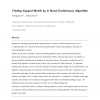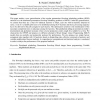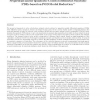439 search results - page 75 / 88 » Maximum entropy methods for biological sequence modeling |
ALMOB
2006
13 years 9 months ago
2006
Background: Bifurcation analysis has proven to be a powerful method for understanding the qualitative behavior of gene regulatory networks. In addition to the more traditional for...
EVOW
2010
Springer
13 years 7 months ago
2010
Springer
Background: Identifying approximately repeated patterns, or motifs, in DNA sequences from a set of co-regulated genes is an important step towards deciphering the complex gene reg...
COR
2010
13 years 9 months ago
2010
This paper studies a new generalization of the regular permutation flowshop scheduling problem (PFSP) referred to as the distributed permutation flowshop scheduling problem or DPF...
TSP
2008
13 years 9 months ago
2008
Graphical models provide a powerful formalism for statistical signal processing. Due to their sophisticated modeling capabilities, they have found applications in a variety of fie...
AUTOMATICA
2011
13 years 4 months ago
2011
We present a framework to solve a finite-time optimal control problem for parabolic partial differential equations (PDEs) with diffusivity-interior actuators, which is motivate...



